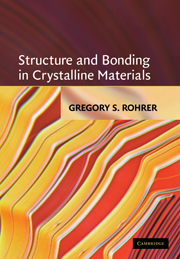Book contents
- Frontmatter
- Contents
- Preface
- 1 Introduction
- 2 Basic Structural Concepts
- 3 Symmetry in Crystal Structures
- 4 Crystal Structures
- 5 Diffraction
- 6 Secondary Bonding
- 7 Ionic Bonding
- 8 Metallic Bonding
- 9 Covalent Bonding
- 10 Models for Predicting Phase Stability and Structure
- Appendix 1A Crystal and univalent radii
- Appendix 2A Computing distances using the metric tensor
- Appendix 2B Computing unit cell volumes
- Appendix 2C Computing interplanar spacings
- Appendix 3A The 230 space groups
- Appendix 3B Selected crystal structure data
- Appendix 5A Introduction to Fourier series
- Appendix 5B Coefficients for atomic scattering factors
- Appendix 7A Evaluation of the Madelung constant
- Appendix 7B Ionic radii for halides and chalcogenides
- Appendix 7C Pauling electronegativities
- Appendix 9A Cohesive energies and band gap data
- Appendix 9B Atomic orbitals and the electronic structure of the atom
- Index
5 - Diffraction
Published online by Cambridge University Press: 23 February 2011
- Frontmatter
- Contents
- Preface
- 1 Introduction
- 2 Basic Structural Concepts
- 3 Symmetry in Crystal Structures
- 4 Crystal Structures
- 5 Diffraction
- 6 Secondary Bonding
- 7 Ionic Bonding
- 8 Metallic Bonding
- 9 Covalent Bonding
- 10 Models for Predicting Phase Stability and Structure
- Appendix 1A Crystal and univalent radii
- Appendix 2A Computing distances using the metric tensor
- Appendix 2B Computing unit cell volumes
- Appendix 2C Computing interplanar spacings
- Appendix 3A The 230 space groups
- Appendix 3B Selected crystal structure data
- Appendix 5A Introduction to Fourier series
- Appendix 5B Coefficients for atomic scattering factors
- Appendix 7A Evaluation of the Madelung constant
- Appendix 7B Ionic radii for halides and chalcogenides
- Appendix 7C Pauling electronegativities
- Appendix 9A Cohesive energies and band gap data
- Appendix 9B Atomic orbitals and the electronic structure of the atom
- Index
Summary
Introduction
Diffraction is the principal means of determining the structure of crystalline matter. There are a number of experimental methods that employ a variety of radiation sources (X-ray, electron, neutron), but a single interference theory underlies them all. Rather than attempt a comprehensive survey of all the experimental techniques, the goal of this chapter is to describe the theoretical underpinnings of diffraction so that we can understand the relationship between diffraction data and crystal structures. In cases where there is a need to be more specific, emphasis is placed on powder X-ray diffraction using a scanning diffractometer; this is one of the most common applications of diffraction. Descriptions of other diffraction methods are limited to brief comments in Section F on the comparative advantages and disadvantages of selected techniques.
Bragg's formulation of the diffraction condition
In 1913, Bragg devised a theory to explain the patterns that were observed when X-rays were scattered from crystalline materials. At this time, it was already widely believed, based on other evidence, that atoms were arranged periodically in crystals. Although X-rays scatter from individual atoms and the most accurate model treats each atom in the crystal as a source of scattered radiation (this more complete model is developed in the next section), Bragg's observations can be explained using the simplified model illustrated in Fig. 5.1. Specifically, we will assume that X-rays are scattered by parallel planes of atoms.
- Type
- Chapter
- Information
- Structure and Bonding in Crystalline Materials , pp. 205 - 262Publisher: Cambridge University PressPrint publication year: 2001

